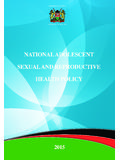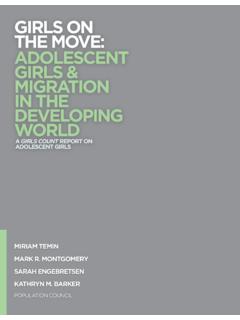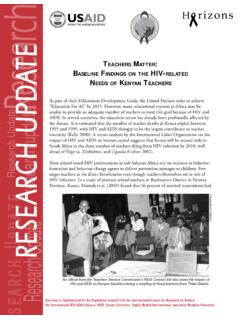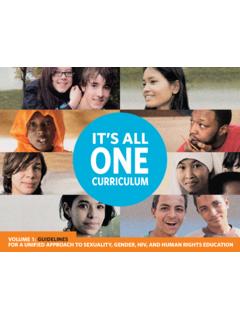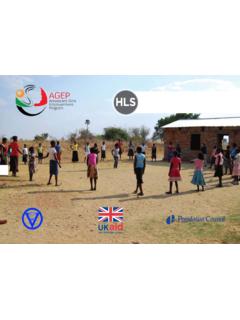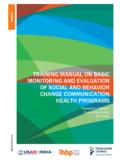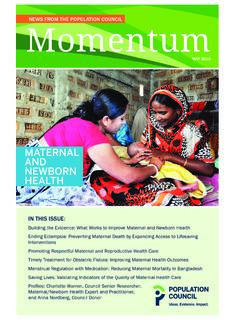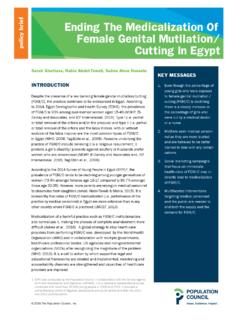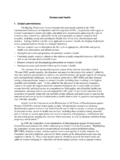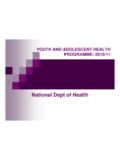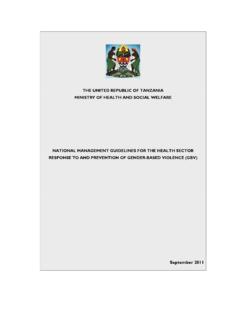Transcription of HLS HEALTH AND LIFE SKILLS CURRICULUM - …
1 HLS HEALTH AND life SKILLS . CURRICULUM . The Population Council confronts critical HEALTH and development issues from stopping the spread of HIV to improving reproductive HEALTH and ensuring that young people lead full and productive lives. Through biomedical, social science, and public HEALTH research in 50 countries, we work with our partners to deliver solutions that lead to more effective policies, programs, and technologies that improve lives around the world. Established in 1952 and headquartered in New York, the Council is a nongovernmental, nonprofit organization governed by an international board of trustees. Population Council One Dag Hammarskjold Plaza New York, NY 10017.
2 Tel: 212-339-0500. Fax: 212-775-6092. Email: Email: Population Council Zambia Plot 3670 No. 4 Mwaleshi Road Olympia Park, Lusaka P/Bag RW 319X, Lusaka 10101, Zambia Lusaka, Zambia 10101. Tel: +260 211 295925. 2013 The Population Council, Inc. Written permission from the Population Council is required for any reproduction or distribution of more than fifty (50) copies per year, any electronic reproduction or any major change in content. For inquiries regarding rights and permission, please contact Sections of this book may be reproduced, translated or adapted with minor changes to meet local needs, provided they are distributed free or at cost and not for profit and provided that any changes maintain the integrity of the book.
3 Please inform the Population Council of plans to translate these materials into another language and provide one (1) copy of the publication. This CURRICULUM has been adapted from several sources, which are listed in the references section. Please include the following statements on all section reproductions: Reprinted from Population Council: life SKILLS and HEALTH CURRICULUM for the Adolescent Girls Empowerment Program (AGEP). Table of Contents Introduction .. 1 life SKILLS 112 Leadership 239. Overview of AGEP.. 1 Session 1: I Have Healthy Relationships.. 113 Session 1: Leadership .. 240. Beneficiaries.. 1 Session 2: Reasons to Delay Sex.
4 120 Session 2: Community Service Putting CURRICULUM Structure .. 2 Leadership into Action.. 244. Session 3: Strategies for Delaying Sex .. 124. Before the Program Begins.. 4. Session 4: Passive, Assertive, Aggressive.. 130 Human Rights .. 249. General Facilitation Tips.. 4. Session 5: Drugs, Alcohol and Other Mind- Session 1: Human Rights and Children's Rights.. 250. Talking about Sensitive Issues.. 5. Altering Substances.. 136. Working with Parents.. 6 Session 2: Sexual and reproductive HEALTH Session 6: Peer Pressure .. 141 Rights.. 256. Participatory Teaching Methods.. 7. Session 7: Making Good Decisions.. 146 Session 3: HIV and AIDS and Human Rights.
5 263. Session Structure.. 8. Session 8: How to Communicate with Adults.. 152 Appendixes 268. Introductory Sessions 10. Session 9: How to Communicate with a Partner.. 156. Session 1: What to Expect Part 1.. 11 Glossary of Terms 269. Session 10: Managing Stress, Anger, and Session 2: What to Expect Part 2.. 17 Conflict.. 161 Appendix A: Additional Topical Information 274. Session 3: Teamwork.. 21 The Menstrual Cycle.. 274. Session 11: Conflict Resolution and Problem Session 4: His and Hers (Gender Roles).. 26 Solving SKILLS .. 168 Reproduction and Pregnancy.. 276. Session 5: Communication.. 32 Emergency Contraception.. 278.
6 HIV, AIDS, and STIs 174. Session 6: Self-Esteem.. 38 Zambia's Abortion Act and Regulations.. 279. Session 7: Goal Identification The Road of life .. 42 Session 1: HIV and AIDS.. 175. Childbirth and Breastfeeding .. 281. Session 8: Goal Setting and Achieving.. 46 Session 2: Myth or Fact? .. 185. Tips for Teaching about HIV and AIDS.. 282. Session 9: My Relationships.. 51 Session 3: HIV Testing and Counseling.. 193. Background Information on HIV and AIDS.. 283. Session 4: Risky Behavior .. 198 Frequently Asked Questions About HIV and AIDS.. 284. reproductive HEALTH 55. Session 5: The Relationship of STIs and HIV HIV and AIDS and Human Rights.
7 286. Session 1: life Cycle.. 56. and AIDS.. 203. Session 2: My Body Is Changing Am I Normal?.. 60. Session 6: Stigma and Discrimination in Appendix B: Participatory Facilitation Session 3: How Does Pregnancy Happen, Anyway?.. 66 HIV-Positive People.. 210 Resources 288. Session 4: Preventing Unintended Pregnancy Trust-Building Activities.. 288. (Contraceptives).. 75 Gender and Gender-Based Violence 215. Group Formation Activities.. 295. Session 5: reproductive Myths.. 83 Session 1: Sexual Exploitation.. 216. Icebreaker Activities (from The International Session 6: Sexual Desire.. 89 Session 2: How to Report and Avoid Cases HIV/AIDs Alliance) 297.
8 Session 7: Unsafe Abortion.. 93 of Sexual Violence.. 223. References 305. Session 8: Abortion and Stigma.. 100 Session 3: Rape and Gender Violence.. 228. Session 9: Maternal Mortality .. 106 Session 4: Preventing Unwanted Advances.. 235. Acknowledgments This manual was adapted by Averie Baird, Bwalya Mushiki, Cassandra We would like to acknowledge several organizations whose materials Burke, Deogratias Chileshe, Diana Bulanda, Karen Austrian, Natalie Jackson have been adapted or used in this CURRICULUM including: Elizabeth Hachonda, and Pamela Nyirenda. Glaser Pediatric AIDS Foundation, Exhale, The Guttmacher Institute, International HIV and AIDS Alliance, International Alliance for Youth Technical input was provided by Abigail Tuchili, Alice L.
9 Bwalya, Andrew Sports, International Labor Organization (ILO), International Sexuality Saka, Andrew Tandeo, Benjamin Mwape, Chanda Katongo, Chikonde Ngwira, and HIV CURRICULUM Working Group, Ipas, Johns Hopkins Bloomberg Chinyama Augustine, Diana B. Shalala, Diana Macauley, Eugenia Temba, School of Public HEALTH /Center for Communication Programs, Joint Febby Imbula, Francis Kapapa, Gershom Banda, Hamaundu Hachonda, United Nations Program on HIV/AIDS (UNAIDS), Margaret Sanger Centre Izek Jere, Josephine T. Mukandawire, Kamanda Mwelwa, Mara Hildebrand, International, Mexican Institute for Research of Family and Population Martin Chidwayi, Michelle Hunsberger, Misheck Mwanza, Mwenda Mweetwa, (IMIFAP), Mobilizing Access to Maternal HEALTH Services in Zamba Mwenya C.
10 Mabuku, Nambula Kachumi, Nelson Banda, Precious Njamba, (MAMaZ), Motivational Centre for Africa's Transformation (MoCAT), Richard Mwape, Shadrick Kaputa, Sue Gibbons, Yvonne Haching'anju, and National Institutes of HEALTH (NIH), One Love Southern Africa Campaign, Zigeville Ndlovu. Peace Corps, Project Concern International, Population Council, Program for Appropriate Technology in HEALTH (PATH), Queensland HEALTH Australia, Sustainability Through Economic Strengthening Prevention an Support for Orphans and Vulnerable Children, Youth and Other Vulnerable Populations (STEPS OVC/Consortium) Zambia, United Nations Children's Fund (UNICEF), United Nations High Commissioner for Refugees (UNHCR), United Nations Population Fund (UNFPA), United States Agency for International Development (USAID), World HEALTH Organization (WHO), and World Young Women's Christian Association (YWCA).
